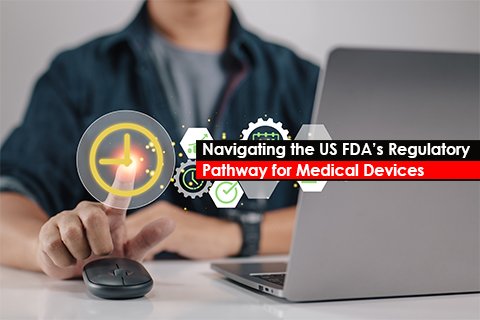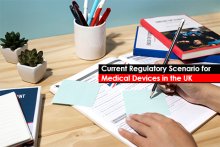The journey of bringing a medical device to the United States (US) market is a complex process governed by the US Food and Drug Administration (FDA). Manufacturers must understand the US FDA’s Regulatory pathway to ensure that their devices meet the necessary standards of safety and efficacy. This blog provides an overview of the US FDA’s Regulatory framework for medical devices, the types of submissions it covers, the timelines, and key considerations for navigating the agency’s approval process.
Understanding US FDA’s Regulatory Framework
The US FDA classifies medical devices into the following three (03) categories, based on the level(s) of risk they pose to patients:
- Class I Devices: These devices are deemed to be low risk and are subject to the least Regulatory control.
- Class II Devices: These devices are at a higher risk than Class I devices and require greater Regulatory control to provide reasonable assurance of a device’s safety and efficacy.
- Class III Devices: These devices are the highest-risk devices and are typically the ones that support or sustain human life, are of substantial importance in preventing the impairment of human health, or present a potential, unreasonable risk of illness or injury.
Types of US FDA Submissions for Medical Devices
Depending on the classification and novelty of a medical device, manufacturers may have to submit one (01) of the following documents:
- Pre-market Notification or 510(k): This is required for most Class II devices and some Class I devices. A 510(k) submission demonstrates that a device is as safe and effective as a legally marketed device (predicate).
- Pre-market Approval (PMA): This is the most stringent type of device marketing application that the US FDA requires, and it is for Class III devices that support or sustain human life or carry a significant risk of illness or injury.
- De Novo Classification: This pathway is for low- to moderate-risk devices that do not have a valid predicate device.
- Humanitarian Device Exemption (HDE): This exemption is applicable to devices that treat or diagnose diseases affecting fewer than 8, 000 individuals in the US per year.
- Investigational Device Exemption (IDE): This exemption allows the use of an investigational device in a clinical study for the purpose of collecting safety and efficacy data.
Timelines and Considerations
The timelines involved in the US FDA’s Regulatory pathway for medical devices vary, depending on the type of pre-market submission required for the device. Here are the general timelines for the most common types of submissions:
- Pre-market Notification or 510(k): A manufacturer must submit a 510(k) application to the US FDA at least ninety (90) days before they intend to market their device. The US FDA then takes ninety (90) days to review the submission and determine whether the device has Substantial Equivalence (SE) with a legally marketed device.
- Pre-market Approval (PMA): The PMA process is more intricate and is typically required for high-risk medical devices. The US FDA’s goal is to reach a decision on a PMA application process within one hundred and eighty (180) days of receiving the submission, although the process can take longer if additional information is required.
- De Novo Application: In cases where a device is novel and not substantially equivalent to an existing device, but the risk does not warrant a PMA, the manufacturer can make a De Novo application request. The US FDA aims to decide on De Novo requests within one hundred and twenty (120) days from the date of application.
- Breakthrough Devices Program: This is a voluntary program intended to expedite the development and review process of certain devices that provide more effective treatment or diagnosis for life-threatening or irreversibly debilitating diseases. The specific timelines can vary, based on the complexity of the device and the amount of interaction between the US FDA and the device sponsor.
- Humanitarian Device Exemption (HDE): For devices that are intended to treat or diagnose conditions affecting fewer than 8, 000 individuals in the US per year, the manufacturer can submit an HDE. The US FDA aims to review HDE applications within seventy-five (75) days from the date of submission.
Some of the prerequisites that manufacturers should also consider include:
- Quality System Regulation (QSR): This includes requirements related to the methods, facilities, and controls used for the design, manufacture, packaging, labeling, storage, installation, and servicing of all finished devices.
- Clinical Trials: Some devices may require clinical trials to demonstrate their safety and efficacy.
- Labeling: Accurate and comprehensive labeling is essential to attain the US FDA’s approval.
- Cybersecurity: For devices that use software or are connected to networks, robust cybersecurity measures must be in place.
- Post-market Surveillance (PMS): After a device is on the market, manufacturers must comply with PMS requirements to monitor their device’s performance and report any adverse events that may occur.
The US FDA provides the following resources to assist manufacturers:
- Device Advice: This is an online resource that explains medical device laws, regulations, guidance, and policies throughout a product’s lifecycle.
- Center for Devices and Radiological Health (CDRH) Learn: This is an online portal offering courses on various aspects of the Regulatory process.
- Guidance Documents: The US FDA publishes documents that represent the current perspectives on a topic and can be helpful in preparing submissions.
- Pre-Submission Program: Manufacturers can request feedback from the US FDA before making a formal submission.
Thus, navigating the US FDA’s Regulatory pathway requires careful planning coupled with a thorough understanding of the process. Manufacturers must stay informed about the latest regulations and guidance documents, prepare comprehensive submissions, and engage with the US FDA throughout the process. By doing so, they can increase the likelihood of a successful outcome and bring their medical devices to the US market in a timely and compliant manner. To get assistance with your US FDA-related medical device requirements, contact Freyr now!





